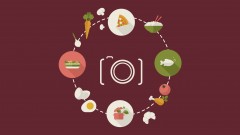These are 7 specific strategies that I focus on while capturing Stunning food photos. Here�s what I�m going to teach you in this post:-
1. Ingredients & color
2. Connection with people
3. Landscapes ( yep!)
4. Angles & depth
5. Lighting
Learn these 5 actionable tips that can Instantly inprove your photo game. � https://wordpress.com/post/xcape...
1. Ingredients & color :- You want to share a photo of the great new dish just prepared, but the photo looks flat, bland & tasteless. No worries! You can instantly make it come alive by adding some ingredients to the shot & playing with the colors involved. The ingredients even make interesting props.
Food photography is an incredibly visual subject and just like any other photography the same principles of light, colour & composition apply here.
When thinking of food Photography don�t just consider the cooked food or the people eating it � or in other words, the final product. Instead focus on every step. Cause even the process has something interesting to offer. Try capturing the different moments in the process.
Add ingredients (that are used in preparing the dish) to the shot, they will help you narrate an amazing story. Experiment with the different ingredients, the spices, the vegetables, fruits and place then in the frame in a seemingly careless manner.
Try spilling a bit of the food on the surface. Even add the dirty dishes & spoons & forks (with bits of food still clinging to them) into the picture. This will add a whole new charming touch of Imperfection to the shot.
No matter what you�re shooting, adding the ingredients gives the viewer an idea of what�s in the dish. Also don�t forget to garnish the food � lemon slices, onions, carrots, chili, parsley�.whatever. You�ll not believe the difference a little garnish makes. Garnishing your food really helps you tell a good story.
Think of the prepared food as a painting, and the ingredients as the colors used. Imagine the scene of a color palette with the colors spread all over it. How appealing it looks! Allowing the ingredients in the shot helps you create the same appeal.
Notice all the colors in your food, and get an idea of how they play off with other, and what aesthetic they bring out. You�d also want to keep the colors saturated. Warm tones works the best. Studies have shown that certain colors can trigger sensory reactions in the brain that increases appetite.
https://flavourjournal.biomedcen...
Warmer colors like � red, yellow, orange works best in increasing appetite. Green gives a more natural & organic feel to your photographs.
Sometimes, not always, even cooler tones (blue, purple) works great like � blueberries, grapes.
Use the color�ingredients & make the photo look tasty.
2. Connection with people :- Have you ever watched carefully the interactions people have with food? Maybe your mother cooking in the kitchen, or people in the vegetable stores, or how people gather around food during family gatherings, or any spontaneous moments while eating or interactions between food & people. They reveal so much about the culture & people of the region.
Try capturing these tiny moments. Cause I�ve seen that often photographers overlook this aspect of the food. The link that it has with people. Explore it! Trust me, they create fascinating stories. And they always visually pays off.
3. Landscapes / Composition:-
Landscape photography, when referred to nature, captures the different elements present in nature � mountains, lakes, trees, rivers, plains, fields, deserts.
In the exact same way in food Photography landscapes can be used strategically to narrate an interesting story. For example � use messy spoon to convey movement, add drips & crumbs for emotions & you can add tension to the scene through compositionally placed ingredients.
Another crucial aspect is mood. Different elements create different mood in your photograph. Some of the moods that you can create are:-
1. Rustic :- in order to achieve this mood use warm tones, shadows, a little of dark & only natural light like light from a window.
2. Bright mood :- you can create this mood by using more if white � white background, white props (clothes, plates, tables), lots of light. Your ultimate shot should look neat, clean & hygienic.
You might even consider overexposing the images a bit, not much, to bring in the bright feeling. We�ll discuss the lighting in details later.
3. Casual mood :- to achieve this mood avoid photographing during harsh light. Instead do your shot at dusk or Dawn, when the light is more diffused, soft, mellow & creates long shadows. Plce the whole setup next to an open window.
Another benefit of shooting at this time of the day � the texture is very nicely and appropriately highlighted and there is also less contrast in shadows.
4. Dark mood :- this one�s my favorite. And they also receive lot more engagement on my Instagram account https://www.instagram.com/x._cape/
To achieve this look you must create shadows, and in order to do that use less light. Allowing only a portion of the food to be lit. Natural light � light from a window, is perfect.
And for best results use black backgrounds � for example, a non-stick pan for frying eggs gives stunning results.
4. Angles & depth :- You might have great composition, great emotions, background, lighting & everything perfect�but the wrong angles can absolutely be devastating to your efforts. So let�s get the angles straight!
The motive in using angles is that which part of the food you want to emphasize & showcase in front of the viewer. For example with a sandwich you might just want to emphasize the part where the bread is cut into half, and reveal the juiciness & textures & colors of the fillings.
There are 3 main angles used in food Photography � three-quarter view, side view, overhead view. Below are the examples of each kind in the respective order. (Notice the position from which the subject is being observed, that�d give you an idea about the angles.)
Study still-life compositions and try exploring what emotions do the different angles convey. It�s always about the best possible angle to showcase your dish.
In fact try any angle that might portray the food from an angle not explored by others. Trying something different is the key. Cause then you�ll be able to create the emotion left unexplored by others.
5. Lighting:- Lighting is everything. It alone can make or break your photograph. It brings out the intimate details & textures & color balance in your photograph, & also makes the food look more appetizing & yummy. Choice of lighting is done in a specific manner as to decide which aspect of the food you want to emphasize � the juiciness, the crispness or the texture.
You can light the subject from any possible direction. Lighting the subject from behind is the best option in most cases. It makes the dish look more appealing & avoids it from looking flat & bland. It�s a great way to bring out the shadows and the subtle textures in your food. (Place the subject in between the light source & the camera.)
This is a picture where the subject is lit from behind. Notice how gentle shadows are created in front. And the texture is vivid.
Backlight also helps to makes any smoke or steam visible. And it adds a whole different charm & aesthetic to your photo.
Try avoiding harsh light as in midday, Cause the shadows created at that point of day creates harsh & strong shadows which in turn makes the food look unappetizing. The flash of your camera can have the same negative effect.
This is the same photo that we encountered in the beginning. The major difference is caused here by excessive light in the left image. And that it ruins it all. Turn off the flash while clicking photos. And also turn off any lamps or overhead lights present. Just the natural light is sufficient.
Use diffused light as in golden hour. ( WordPress.com check this out for golden hour.) This time of the day is perfect for any kind of photography. If you�re using natural light source, try placing the subject close to an open window or opt for an overcast day. Open out as many windows (and doors if possible) around the area where you are taking the pictures. Just make sure you�re allowing enough light to enter. Then you might create shadows accordingly. You don�t want to miss out on the Shadows, cause shadows create drama. I usually take most of my food photographs beside my kitchen window & then experiment with the shadows by blocking the light from different angles.
But suppose you�re too busy & you don�t have just enough time to wait for the golden hour. Then you might also use the harsh light of the midday sun, or lamp, but in that case, you�d have to add a little filter to it. You might buy some filters.
Or the easiest DIY filter is semi-sheer white curtains, white napkins, sheer towels, bedsheet & it�ll create the perfect mellower light that you�re searching for.
And the worst enemy to photographing food is lighting from the front. It makes your food look excessively bright and harsh, destroying the subtle textures. And you�ll end up with a bland, tasteless image of your actually tasty dish.
So now we�ve come to the end of this topic.
The topics, techniques, & tactics mentioned & described here are guaranteed to make you an awesome food photographer. All you have to do is just click! Click! Click! & watch your food Photographs become more delicious�more vibrant..more emotive�more heart-touching�.and obviously more mouth-watering








